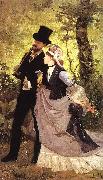Wholesale Oil Painting No Minimum |
|||||||||||
|
|
|||||||||||

|
|||||||||||
|
|
|
||||||||
Ernest Duez1843-1896 French Ernest Duez Location French painter. He studied under Isidore-Alexandre-Augustin Pils and made his debut at the Salon in 1868. One of his earliest paintings, The Honeymoon (1873), caused a scandal at the Salon owing to its depiction of two lovers in modern dress walking through a sunlit forest. His triptych St Cuthbert (1879; Paris, Pompidou) was hailed as a masterpiece of modern art and bought by the State for the Musee du Luxembourg in Paris. The painting depicts the stages of St Cuthbert life, from child to hermit. Contemporary viewers were struck by the artist use of a real landscape setting, based on Villerville in Normandy where Duez spent much of his time. In addition to genre, religious and history paintings, in 1876 he began to produce portraits: Alphonse de Neuville (1880; Versailles, Cheteau) is a typical example. His brooding, suggestive portrait of Mme Duez (1877; see Montrosier, 1896, p. 429) shows the influence of Symbolism. However, he soon returned to painting works that were essentially landscapes, such as the decorative panel Virgil Seeking Inspiration in the Woods (1888) for the Sorbonne and a pair of allegorical figures, Botany and Physics (1892), for the Hetel de Ville in Paris. He also devoted time to applied art, producing a variety of textile designs. His work was praised for its adept use of colour and for bringing what were seen as modern techniques to traditional subjects. |
||||||||
|
|
||||||||
Honeymoon
Honeymoon Painting ID:: 1014 |
1873
Musee des Beaux-Arts, Arras 1873 Musee des Beaux-Arts, Arras |
|||||||
|
|
||||||||
|
Moritz von Schwind Austrian Romantic Painter, 1804-1871 Austrian painter and illustrator. He studied at the Akademie der Bildende K?nste in Vienna (1821-3), where he was influenced by the Biedermeier genre painter Peter Krafft and the Nazarene painter Ludwig Ferdinand Schnorr von Carolsfeld. He made copies after the Old Masters at the Belvedere in Vienna, exploring especially D?rer, Albrecht Altdorfer, Raphael and Titian, which completed his early, largely autodidactic experience of art. His friendship with Franz Schubert, the poet and playwright Franz Grillparzer and the painters Ferdinand and Friedrich Olivier, as well as the cultural environment of Biedermeier Vienna in his years there between 1823 and 1828, shaped his spiritual development as a painter. His love of music inspired his later 'symphonic' compositions and flowing linear rhythms. Extensive reading of the work of Romantic writers such as Achim von Arnim, Clemens von Brentano, Ludwig Tieck, Friedrich Heinrich von Hagen and the brothers Jacob and Wilhelm Grimm helped prepare his mature pictorial themes of fairytales, legends and sagas. He was unsuccessful as a painter and eked out a meagre livelihood by drawing naturalistic genre scenes for engravers, while occasionally selling a painting. Walk before the City Gate Honeymoon mk156 1867 Oil on wood 52x41cm |
||||||||
|
|
||||||||
|
Prev Next
|
||||||||
|
|
||||||||
|
Related Paintings to Moritz von Schwind :. |
||||||||
|
|
||||||||
|
CONTACT US |

